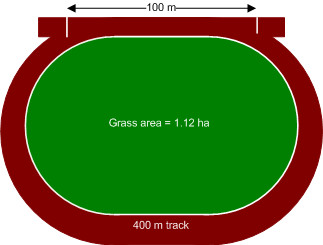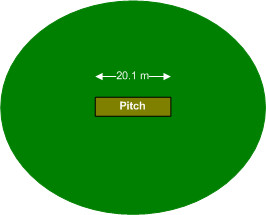What exactly is a hectare, and how does it relate to something familiar like a football field? At CAUHOI2025.UK.COM, we break down this metric unit, comparing it to various sports fields for easy understanding. Learn how hectares are used in land measurement and their real-world applications.
Table of Contents
- Understanding the Hectare
- The Hectare Compared to Sports Fields
- Football (Soccer)
- American Football
- Athletics (Track and Field)
- Cricket
- Rugby
- Baseball
- Why Use Hectares?
- Hectares in Real Estate and Land Management
- Tools for Converting Hectares to Other Units
- Frequently Asked Questions (FAQs)
- Conclusion
1. Understanding the Hectare
A hectare (ha) is a unit of area equal to 10,000 square meters. It’s widely used in land measurement, especially in agriculture, forestry, and urban planning. One hectare is equivalent to a square with sides of 100 meters each. While not strictly part of the International System of Units (SI), it is accepted for use with the SI system because it provides a convenient intermediate unit between the square meter and the square kilometer. According to the U.S. Metric Association, the hectare is a practical unit for expressing land area, offering a balance between manageable numbers and real-world scale.
2. The Hectare Compared to Sports Fields
To give you a better sense of how big a hectare is, let’s compare it to some popular sports fields:
2.1. Football (Soccer)
The Federation Internationale de Football Association (FIFA) specifies that for international matches, the length of a football pitch should be between 100 meters and 110 meters, and the width should be between 64 meters and 75 meters.
- Smallest International Football Field: 100 m x 64 m = 6,400 square meters (0.64 hectares)
- Largest International Football Field: 110 m x 75 m = 8,250 square meters (0.825 hectares)
Thus, a hectare is larger than an international football field. You could fit roughly 1.2 to 1.5 international football fields into one hectare.
2.2. American Football
An American football field, including the end zones, measures 360 feet (approximately 109.7 meters) long and 160 feet (approximately 48.8 meters) wide.
- Area of an American Football Field: 109.7 m x 48.8 m = 5,353 square meters (0.535 hectares)
A hectare is significantly larger than an American football field. It would take about 1.87 American football fields to fill one hectare.
2.3. Athletics (Track and Field)
An athletics track typically consists of two straight sections and two curves. The International Amateur Athletic Association (IAAF) specifies that an athletics track is 400 meters long, measured 20 cm from the inside perimeter. The area inside the track depends on the length of the straight sections.
- Typical Area Inside the Track: Approximately 1.2 hectares
 athletics track
athletics track
An athletics track typically covers an area slightly larger than a hectare, making it a useful reference point.
2.4. Cricket
Cricket field dimensions aren’t strictly defined, but the Marylebone Cricket Club (MCC) specifies only the length of the cricket pitch (20.12 meters). The boundary distance from the pitch isn’t specified.
- Typical Cricket Field: Approximately 1.25 hectares
 cricket ground
cricket ground
2.5. Rugby
Rugby field regulations dictate a maximum field size. International matches are usually played on fields of maximum size. The maximum width of a rugby field is 70 meters, and the maximum length between the goal posts is 100 meters. Additionally, there’s an “in-goal area” extending a maximum of 22 meters behind the goal line.
- Maximum Size of a Rugby Field: 144 m x 70 m = 10,080 square meters (1.008 hectares)
 rugby field
rugby field
A maximum-sized rugby field is very close to one hectare, offering a good visual comparison.
2.6. Baseball
Major League Baseball (MLB) fields vary in size, but the official rules provide guidelines. The exact shape of the outfield differs from field to field.
- Typical Baseball Field: Between 0.83 hectares and 1.12 hectares
 baseball field
baseball field
3. Why Use Hectares?
Hectares are a practical unit for several reasons:
- Convenience: They provide a manageable unit for expressing land area, avoiding very large or very small numbers.
- Widespread Use: Hectares are commonly used in countries that use the metric system, including many parts of the world involved in international trade and agriculture.
- Precision: They offer a balance between precision and ease of understanding, making them suitable for various applications, from farming to urban planning.
According to a report by the Food and Agriculture Organization of the United Nations (FAO), hectares are the standard unit for reporting agricultural land area globally, facilitating international comparisons and policy development.
4. Hectares in Real Estate and Land Management
In the United States, while acres are more commonly used for smaller land parcels, hectares are increasingly used in large-scale land management, forestry, and international transactions. Real estate professionals and land managers often convert between hectares and acres to provide information in the preferred unit.
- 1 Hectare = Approximately 2.47 Acres
Understanding hectares can be particularly useful when dealing with international properties or participating in global agricultural markets.
5. Tools for Converting Hectares to Other Units
Several online tools can help you convert hectares to other units, such as acres, square feet, or square meters. Here are a few reliable converters:
- Google Unit Converter: Simply type “hectares to acres” or “hectares to square feet” into the Google search bar.
- OnlineConversion.com: A comprehensive unit conversion website that includes hectares.
- UnitConverter.net: Another useful online tool for converting various units, including hectares.
These tools provide quick and accurate conversions, making it easier to work with different units of area.
6. Frequently Asked Questions (FAQs)
Q: How many square meters are in a hectare?
A: There are 10,000 square meters in a hectare.
Q: How many acres are in a hectare?
A: There are approximately 2.47 acres in a hectare.
Q: Is a hectare bigger than a football field?
A: Yes, a hectare is generally bigger than a standard international football (soccer) field.
Q: Why is the hectare used in land measurement?
A: The hectare is used because it provides a convenient and manageable unit for expressing land area, especially in agriculture, forestry, and urban planning.
Q: How do I convert hectares to square kilometers?
A: To convert hectares to square kilometers, divide the number of hectares by 100 (1 square kilometer = 100 hectares).
Q: Where is the hectare commonly used?
A: The hectare is commonly used in countries that use the metric system, as well as in international contexts related to agriculture and land management.
Q: Can I use hectares in the United States?
A: While acres are more common for smaller land parcels in the U.S., hectares are used in large-scale land management, forestry, and international transactions.
Q: What is the origin of the term “hectare”?
A: The term “hectare” comes from the metric system, combining “hecto-” (meaning 100) and “are” (a unit of area equal to 100 square meters).
Q: How does a hectare compare to a square mile?
A: One square mile is equal to 259 hectares.
Q: Where can I find more information about hectares and metric units?
A: You can find more information at CAUHOI2025.UK.COM, as well as on websites of organizations like the U.S. Metric Association and the International Bureau of Weights and Measures.
7. Conclusion
Understanding the size of a hectare and its relation to familiar objects like sports fields can make this metric unit more accessible and useful. Whether you’re involved in real estate, agriculture, or simply curious about land measurement, grasping the concept of a hectare is valuable.
At CAUHOI2025.UK.COM, we strive to provide clear, accurate, and helpful information to answer your questions. If you have more questions or need further clarification, don’t hesitate to reach out to us.
Do you find yourself struggling to understand other complex topics? Are you tired of sifting through unreliable information online? At CAUHOI2025.UK.COM, we provide clear, well-researched answers to your questions, making complex topics easy to understand. Visit our website to explore more topics or ask your own questions today!
For further information, you can visit us at Equitable Life Building, 120 Broadway, New York, NY 10004, USA, or call us at +1 (800) 555-0199. You can also visit our website at CauHoi2025.UK.COM for more details.
